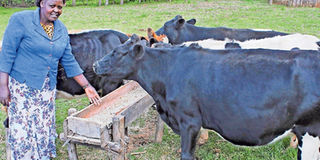Premium
Nakuru targets 100,000 cattle in vaccination against lumpy skin disease

Edna Kirui feeds her dairy cows in Elburgon. Cows should be vaccinated against lumpy skin disease (LSD), black quarter and anthrax (Blanthrax) once per year and foot and mouth disease (FMD) twice per year. PHOTO | JOHN NJOROGE | NMG
At least 100,000 cattle will be vaccinated against foot-and-mouth and lumpy skin diseases in Rongai, Subukia, Kuresoi South, Kuresoi North and Njoro sub-counties in Nakuru County by June.
The drive is already underway in some areas, said livestock department officials.
Lumpy skin is a viral disease spread by biting insects. The virus, closely related to the pox viruses of sheep and goats, causes nodular skin lesions on the animal's body.
Foot-and-mouth disease (FMD) or hoof-and-mouth disease (HMD), on the other hand, is an infectious and sometimes fatal viral disease that affects cloven-hoofed domestic and wild animals.
Livestock and Fisheries Chief Officer Dr Enos Amuyunzu revealed that the vaccination drive aims to protect farmers from losing their animals.
“I urge farmers in the county to heed the call for free vaccinations in their respective sub-counties. The activity is all-inclusive and will cover all intended sub-counties. The county is targeting to vaccinate at least 100,000 cattle,” Dr Amuyunzu said.
“We will also launch a vaccination drive for sheep and goats in the coming days.”
Dr Amuyunzu said the diseases are infectious and occasionally cause deaths, saying calves are particularly affected by lumpy skin disease.
Livestock farming earns Nakuru farmers millions of shillings annually through the sale of meat and milk.
At least 70 per cent of the total land acreage in Nakuru is agriculturally productive, with a large capacity for livestock, goats, sheep production.
The Nakuru County government set aside Sh28 million in the last financial year to upgrade breeds and revitalise livestock farming.
The devolved unit also plans to pump at least Sh90 million in the next two years into helping farmers boost livestock farming and general animal husbandry.
The money will be used, among other goals, to improve breeds through cross-breeding, enable farmers to readily obtain artificial insemination services, launch mega capacity building for farmers on breeds and modern husbandry techniques and provide veterinary extension services in all sub-counties.





